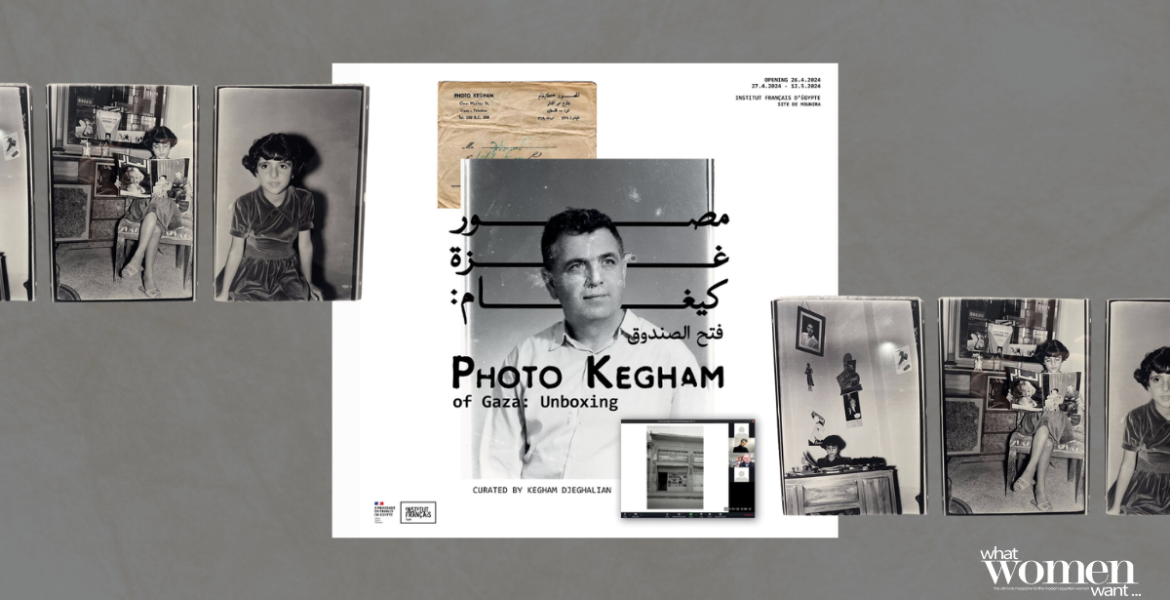“This exhibition is a confrontation with a disrupted and an unmade archive. It is a representation of the work in typology rather than chronology, where historiography becomes secondary, yet inherently alluded to through the subjects and objects of the photographs.”
“Photo Kegham of Gaza: Unboxing” is a meticulously crafted and curated exhibition by Kegham Djeghalian Jr.. It is an exhibition that addresses a fraction of the photographic legacy of Kegham Djeghalian Senior. Djeghalian Jr. primary research focuses on exploring Kegham of Gaza – the person, the photographer, and his legacy. The French Institute in Downtown Cairo is hosting the ‘Photo Kegham of Gaza: Unboxing’ Exhibition until May 12th. The exhibit showcases a curation of photos from Gaza’s first photographer, Kegham Djeghalian. The exhibition is put together by his grandson, artist, and creative director Kegham Djeghalian Junior.
“I embraced this ambiguity in order to articulate the affective and the nostalgic, but also to acknowledge the disrupted narratives and contexts of Kegham’s story and his photos, all of which might seem to paradoxically function as an anti-archival practice. ”
In exploring his granddad’s archives, he grappled with disrupted histories and the idea of an ‘unmade archive’. This is clearly demonstrated in the deliberate absence of captions or dates on the photographs. This concept is crucial for attempting to demystify Gaza: the land, the people, the memory, and the subjective histories that once were.
A dive into the exhibition:
“Running the risk of decontextualizing, I chose to give up trying to identify everyone and trying to precisely date every single photograph. Instead, I opted to engage in a raw confrontation with the photographs.”
The exhibition is divided into 4 themes. The first two, ‘The Studio’ and ‘Gaza Memento,’ map out Kegham’s professional practice and his socio-political engagement. The third, ‘Family Album,’ is an ode to his family. Also, it serves as socio-political context of Gaza in the mid-20th century. The fourth theme, ‘Zoom Call,’ spotlights the complex problems in accessing Kegham’s archival work. Visitors delve into the rich visual history of Gaza as captured by the lens of Kegham Djeghalian. His photographic legacy transcends mere documentation. It offers a vivid portrayal of the social, official, political, and everyday aspects of life in Gaza.
Djeghalian Sr.’s story:
Kegham Djeghalian Senior is a toddler survivor of the 1915 Armenian genocide. He moved around to Syria and grew up across different cities of the Levant. He decided to settle in Gaza and open ‘Photo Kegham’ in 1944, the first photography studio in Gaza. Many consider him the godfather of photography in Gaza. He mentored and supported many young photographers, aiding in the democratization of photographic practice. For four decades, Kegham steadily inscribes the photographic history and memory of Gaza through his social, official, political, documentary and studio photography during its turbulent history.
“Knowing that his photographic archive in Gaza is practically unattainable to me, that is all I had of his legacy when I started this project in 2018. I unboxed the negatives and documents, scanned and examined them, but the labor of creating or curating this small family archive still seemed colossal to me.”
Today, Djeghalian Sr.’s vast archive is more endangered than ever, along with the entirety of Gaza. Israel’s genocidal campaign continue to rain bombs on Palestinians and their homes. The exhibition forces the visitors to confront the haunting realities of the Palestinian cause. The absolute normalcy of their lives in comparison with the images associated today is daunting.
Dabke
Accompanying the exhibition are Palestinian folklore dancers performing Dabke, a traditional Palestinian folk dance that embodies the resilience, unity, and cultural heritage of the Palestinian people. With its lively rhythm and synchronized footwork, Dabke serves as a symbol of solidarity, often performed at weddings, festivals, and other communal celebrations. Not only does it showcase Palestinian culture, but also fosters a sense of belonging and connection among its participants. Through Dabke, Palestinians express their collective identity, perseverance, and defiance in the face of adversity, preserving their cultural legacy amidst ongoing challenges.
Backstory of the Exhibition:
This exhibition, previously displayed in Egypt’s capital in 2021 for Cairo Photo Week, shows just a fraction of Djeghalian Sr.’s full archive. Even the lack of captions, descriptions, or dates on most photos demonstrates the disrupted narratives and contexts within which life in Gaza takes place. Through his grandfather’s work, Kegham Jr. reaches back through his own heritage, depicting the very ordinary lives of Gaza’s people in a context that is now impossible to imagine during the ongoing genocide.

